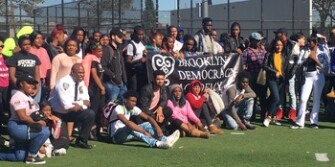This post is by Dez-Ann Romain, Principal of Brooklyn Democracy Academy, a transfer high school in Brooklyn, NY.
Today’s post is the practitioner perspective on Monday’s post: Persisting Students’ Pathways and Experiences Through High School

While New York City has seen a large rise in graduation rates over the last decade, there is still a sizeable percentage of students who do not graduate on time. According to analysis from the Research Alliance for New York City Schools, there are about 12,000 “persisting students” per entering class—or about one in five—who fall behind and end up persisting into a fifth or sixth year of high school. Transfer schools serve these students and others who are considered high needs for a variety of reasons. These schools are one of the myriad of ways the NYC Department of Education works to address hurdles often associated with race, equity, diversity, and access throughout the educational system.
Transfer schools create individualized plans to support persisting students on their journey to graduation and beyond. While there are a number of specific models, transfer schools are typically a small community by design, with about 150 to 220 students, small classroom sizes, tailored instruction, college and career exploration, onsite Community Based Organization (CBO) supports, and paid Learn to Work internships. My school, Brooklyn Democracy Academy, is a transfer high school that serves a population of 212 persisting students. These students, who generally fall in the age range of 17-21, are referred to the program by staff members in their high school, family members, peers, and/or the NYC enrollment offices. Our CBO assists with interviewing every potential student and guardian during our intake process. It is during this process that the initial bonds or relationships are developed between transfer school staff, students, and families so we can assess a student’s fit for the program and communicate the importance of perseverance once they are enrolled.
For those of us working in transfer schools every day, it is important to have research that explores our students’ needs, emphasizes promising strategies, and creates suggestions for improving the work and systems of transfer schools and other alternative programs.
Use of Research Findings in Practice
The Research Alliance’s recent persisting students study—discussed in Monday’s blog post—reinforced the importance of many of the strategies we use with our students. To understand the nature of a transfer school, it’s helpful to take a look inside. At our school, as you walk through the hallways at the start of the school day, there is a sense of calm that hangs in the air. Students walk past their teachers and say good morning as they go to the cafeteria to select their breakfast. They gather around, looking at the options provided, and discussing whether breakfast was better than the day before. Down the hall, you can hear students asking for a cup for water, a plate, a fork or a spoon, which gives staff time to bond with them through laughter. Throughout the day, the sense of calm crescendos into an excited buzz that reflects an innumerable amount of emotions from our students. Not one student will walk through this hallway unknown, for they aren’t just students. Indeed, they are family.
As educators and school leaders, it is our job to utilize these moments to connect with students with a simple word, a smile, a hug, a conversation, a look. These moments, though seemingly informal, can be the difference between a student attending school or not, going to class regularly or not, and ultimately whether they graduate from high school, are gainfully employed, and/or attend college. It is imperative to consistently communicate to students how important they are by routinely making decisions that are based on their needs.
The Research Alliance’s research underscores why this work is so important—and challenging. Researchers noted that persisting students are often chronically absent early in their high school career and struggle academically in middle school. Persisting students are also likely to be living in poverty and struggle to maintain relationships with school staff prior to transfer school enrollment. Transfer schools work with students dealing with a host of challenges, and it is our job to continuously find ways to create interventions that help students achieve social-emotional and academic success. Many of us who work with these students rely on rigorous research to inform our strategies, and we’ve learned that relationships, consistency, and innovation make a difference for persisting students.
At the system level, this research can help illuminate how students and their families are being identified, educated, and referred to transfer programs, as each program is as different as the students that are enrolled. Furthermore, research highlighting the work that is done in transfer schools and the experiences of persisting students—considering the challenges that both parties face—is critical to inform policymakers’ ongoing discussions around accountability measures that encompass qualitative, quantitative, traditional, and non-traditional data.
Future Work
As educators move forward and research continues to tell us more about persisting students and which practices serve them most effectively, there are several questions that researchers, policymakers, and practitioners should explore. These include:
How can we advance a system that helps identify, educate, and refer persisting students to promising alternative high school programs?
What are the best accountability measures policymakers can establish to measure the work of alternative programs like transfer schools?
What role do transfer schools play in addressing some of the race, equity, and access barriers of NYC education system?
All of these questions are important guiding inquiries that can inform those seeking to effectively serve persisting students.
Photo courtesy of Brooklyn Democracy Academy